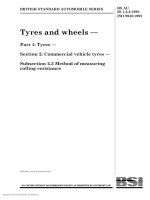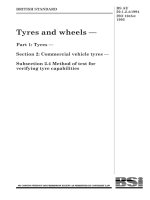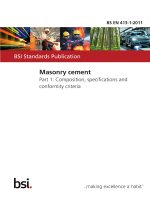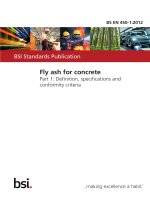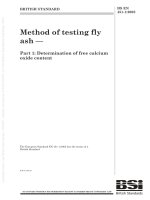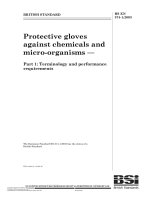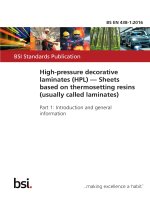Bsi bs en 60794 1 2 2017
Bạn đang xem bản rút gọn của tài liệu. Xem và tải ngay bản đầy đủ của tài liệu tại đây (1.98 MB, 16 trang )
BS EN 60794-1-2:2017
BSI Standards Publication
Optical fibre cables
Part 1-2: Generic specification — Basic
optical cable test procedures — General
guidance
BRITISH STANDARD
BS EN 60794-1-2:2017
National foreword
This British Standard is the UK implementation of EN 60794-1-2:2017. It is
identical to IEC 60794-1-2:2017. It supersedes BS EN 60794-1-2:2014 which
is withdrawn.
The UK participation in its preparation was entrusted by Technical
Committee GEL/86, Fibre optics, to Subcommittee GEL/86/1, Optical fibres
and cables.
A list of organizations represented on this committee can be obtained on
request to its secretary.
This publication does not purport to include all the necessary provisions of
a contract. Users are responsible for its correct application.
© The British Standards Institution 2017.
Published by BSI Standards Limited 2017
ISBN 978 0 580 92212 1
ICS 33.180.10
Compliance with a British Standard cannot confer immunity from
legal obligations.
This British Standard was published under the authority of the
Standards Policy and Strategy Committee on 30 April 2017.
Amendments/corrigenda issued since publication
Date
Text affected
BS EN 60794-1-2:2017
EUROPEAN STANDARD
EN 60794-1-2
NORME EUROPÉENNE
EUROPÄISCHE NORM
March 2017
ICS 33.180.10
Supersedes EN 60794-1-2:2014
English Version
Optical fibre cables - Part 1-2: Generic specification - Basic
optical cable test procedures - General guidance
(IEC 60794-1-2:2017)
Câbles à fibres optiques - Partie 1-2: Spécification
générique - Procédures fondamentales d'essais des câbles
optiques - Lignes directrices générales
(IEC 60794-1-2:2017)
Lichtwellenleiterkabel - Teil 1-2: Fachgrundspezifikation Grundlegende Prüfverfahren für Lichtwellenleiterkabel Allgemeine Anleitung
(IEC 60794-1-2:2017)
This European Standard was approved by CENELEC on 2017-02-16. CENELEC members are bound to comply with the CEN/CENELEC
Internal Regulations which stipulate the conditions for giving this European Standard the status of a national standard without any alteration.
Up-to-date lists and bibliographical references concerning such national standards may be obtained on application to the CEN-CENELEC
Management Centre or to any CENELEC member.
This European Standard exists in three official versions (English, French, German). A version in any other language made by translation
under the responsibility of a CENELEC member into its own language and notified to the CEN-CENELEC Management Centre has the
same status as the official versions.
CENELEC members are the national electrotechnical committees of Austria, Belgium, Bulgaria, Croatia, Cyprus, the Czech Republic,
Denmark, Estonia, Finland, Former Yugoslav Republic of Macedonia, France, Germany, Greece, Hungary, Iceland, Ireland, Italy, Latvia,
Lithuania, Luxembourg, Malta, the Netherlands, Norway, Poland, Portugal, Romania, Serbia, Slovakia, Slovenia, Spain, Sweden,
Switzerland, Turkey and the United Kingdom.
European Committee for Electrotechnical Standardization
Comité Européen de Normalisation Electrotechnique
Europäisches Komitee für Elektrotechnische Normung
CEN-CENELEC Management Centre: Avenue Marnix 17, B-1000 Brussels
© 2017 CENELEC All rights of exploitation in any form and by any means reserved worldwide for CENELEC Members.
Ref. No. EN 60794-1-2:2017 E
BS EN 60794-1-2:2017
EN 60794-1-2:2017
European foreword
The text of document 86A/1767/FDIS, future edition 4 of IEC 60794-1-2, prepared by SC 86A "Fibres
and cables" of IEC/TC 86 "Fibre optics" was submitted to the IEC-CENELEC parallel vote and
approved by CENELEC as EN 60794-1-2:2017.
The following dates are fixed:
•
latest date by which the document has to be implemented at
national level by publication of an identical national
standard or by endorsement
(dop)
2017-11-16
•
latest date by which the national standards conflicting with
the document have to be withdrawn
(dow)
2020-02-16
This document supersedes EN 60794-1-2:2014.
Attention is drawn to the possibility that some of the elements of this document may be the subject of
patent rights. CENELEC [and/or CEN] shall not be held responsible for identifying any or all such
patent rights.
Endorsement notice
The text of the International Standard IEC 60794-1-2:2017 was approved by CENELEC as a
European Standard without any modification.
In the official version, for Bibliography, the following notes have to be added for the standards
indicated
2
IEC 60794-1-21
NOTE
Harmonized as EN 60794-1-21.
IEC 60794-1-22
NOTE
Harmonized as EN 60794-1-22.
IEC 60794-1-23
NOTE
Harmonized as EN 60794-1-23.
IEC 60794-1-24
NOTE
Harmonized as EN 60794-1-24.
BS EN 60794-1-2:2017
EN 60794-1-2:2017
Annex ZA
(normative)
Normative references to international publications
with their corresponding European publications
The following documents, in whole or in part, are normatively referenced in this document and are
indispensable for its application. For dated references, only the edition cited applies. For undated
references, the latest edition of the referenced document (including any amendments) applies.
NOTE 1 When an International Publication has been modified by common modifications, indicated by (mod), the relevant
EN/HD applies.
NOTE 2 Up-to-date information on the latest versions of the European Standards listed in this annex is available here:
www.cenelec.eu.
Publication
IEC 60793-1-40
Year
-
IEC 60793-1-46
-
IEC 60793-2-40
-
IEC 60794-1-1
2015
Title
EN/HD
Optical fibres -- Part 1-40: MeasurementEN 60793-1-40
methods and test procedures - Attenuation
Optical fibres -- Part 1-46: MeasurementEN 60793-1-46
methods and test procedures - Monitoring
of changes in optical transmittance
Optical fibres - Part 2-40: ProductEN 60793-2-40
specifications - Sectional specification for
category A4 multimode fibres
Optical fibre cables - Part 1-1: GenericEN 60794-1-1
specification - General
Year
2016
3
–2–
BS EN 60794-1-2:2017
IEC 60794-1-2:2017 © IEC 2017
CONTENTS
FOREWORD ........................................................................................................................... 3
INTRODUCTION ..................................................................................................................... 5
1
Scope .............................................................................................................................. 6
2
Normative references ...................................................................................................... 6
3
Terms and definitions ...................................................................................................... 7
4
General guidance ............................................................................................................ 7
4.1
Test procedure format ............................................................................................. 7
4.2
Standard atmospheric conditions ............................................................................ 7
4.3
Symbols and abbreviated terms .............................................................................. 7
4.4
Safety and environmental aspects........................................................................... 8
4.5
Calibration .............................................................................................................. 8
4.5.1
Calibration process .......................................................................................... 8
4.5.2
Assessment of uncertainties [1] ....................................................................... 8
4.6
Preconditioning ....................................................................................................... 8
4.7
Guide to qualification sampling ............................................................................... 8
4.8
Optical launch conditions ........................................................................................ 8
4.9
Standard optical test wavelengths ........................................................................... 9
Bibliography .......................................................................................................................... 10
Table 1 – Document overview ................................................................................................. 6
Table 2 – Standard optical test wavelengths ........................................................................... 9
BS EN 60794-1-2:2017
IEC 60794-1-2:2017 © IEC 2017
–3–
INTERNATIONAL ELECTROTECHNICAL COMMISSION
____________
OPTICAL FIBRE CABLES –
Part 1-2: Generic specification –
Basic optical cable test procedures –
General guidance
FOREWORD
1) The International Electrotechnical Commission (IEC) is a worldwide organization for standardization comprising
all national electrotechnical committees (IEC National Committees). The object of IEC is to promote
international co-operation on all questions concerning standardization in the electrical and electronic fields. To
this end and in addition to other activities, IEC publishes International Standards, Technical Specifications,
Technical Reports, Publicly Available Specifications (PAS) and Guides (hereafter referred to as “IEC
Publication(s)”). Their preparation is entrusted to technical committees; any IEC National Committee interested
in the subject dealt with may participate in this preparatory work. International, governmental and nongovernmental organizations liaising with the IEC also participate in this preparation. IEC collaborates closely
with the International Organization for Standardization (ISO) in accordance with conditions determined by
agreement between the two organizations.
2) The formal decisions or agreements of IEC on technical matters express, as nearly as possible, an international
consensus of opinion on the relevant subjects since each technical committee has representation from all
interested IEC National Committees.
3) IEC Publications have the form of recommendations for international use and are accepted by IEC National
Committees in that sense. While all reasonable efforts are made to ensure that the technical content of IEC
Publications is accurate, IEC cannot be held responsible for the way in which they are used or for any
misinterpretation by any end user.
4) In order to promote international uniformity, IEC National Committees undertake to apply IEC Publications
transparently to the maximum extent possible in their national and regional publications. Any divergence
between any IEC Publication and the corresponding national or regional publication shall be clearly indicated in
the latter.
5) IEC itself does not provide any attestation of conformity. Independent certification bodies provide conformity
assessment services and, in some areas, access to IEC marks of conformity. IEC is not responsible for any
services carried out by independent certification bodies.
6) All users should ensure that they have the latest edition of this publication.
7) No liability shall attach to IEC or its directors, employees, servants or agents including individual experts and
members of its technical committees and IEC National Committees for any personal injury, property damage or
other damage of any nature whatsoever, whether direct or indirect, or for costs (including legal fees) and
expenses arising out of the publication, use of, or reliance upon, this IEC Publication or any other IEC
Publications.
8) Attention is drawn to the Normative references cited in this publication. Use of the referenced publications is
indispensable for the correct application of this publication.
9) Attention is drawn to the possibility that some of the elements of this IEC Publication may be the subject of
patent rights. IEC shall not be held responsible for identifying any or all such patent rights.
International Standard IEC 60794-1-2 has been prepared by subcommittee 86A: Fibres and
cables, of IEC technical committee 86: Fibre optics.
This fourth edition cancels and replaces the third edition published in 2013 and
IEC 60794120 published in 2014. This edition constitutes a technical revision.
This edition includes the following significant technical changes with respect to the previous
edition and to IEC 60794-1-20:
a) the multiple cross-reference tables have been deleted and replaced with a higher level
one related to the generic standards;
b) all pertinent text from IEC 60794-1-20 has been included;
c) standard optical test wavelengths have been introduced;
d) this document has been streamlined by cross-referencing IEC 60794-1-1;
–4–
BS EN 60794-1-2:2017
IEC 60794-1-2:2017 © IEC 2017
e) the "No change in attenuation" definitions contained in IEC 60794-1-20 have been
transferred to IEC 60794-1-1;
f)
the title has been modified to reflect the contents of the new edition.
This International Standard is to be used in conjunction with IEC 60794-1-1:2015.
The text of this standard is based on the following documents:
FDIS
Report on voting
86A/1767/FDIS
86A/1775/RVD
Full information on the voting for the approval of this standard can be found in the report on
voting indicated in the above table.
This publication has been drafted in accordance with the ISO/IEC Directives, Part 2.
A list of all parts in the IEC 60794 series, published under the general title Optical fibre
cables, can be found on the IEC website.
The committee has decided that the contents of this publication will remain unchanged until
the stability date indicated on the IEC web site under "" in the data
related to the specific publication. At this date, the publication will be
•
reconfirmed,
•
withdrawn,
•
replaced by a revised edition, or
•
amended.
BS EN 60794-1-2:2017
IEC 60794-1-2:2017 © IEC 2017
–5–
INTRODUCTION
IEC 60794-1-2:2013 comprised a detailed cross-reference table to the new document set, and
general guidance was given in IEC 607941-20. These two specifications have been combined
in this document, which allows for IEC 60794-1-20 to be withdrawn.
–6–
BS EN 60794-1-2:2017
IEC 60794-1-2:2017 © IEC 2017
OPTICAL FIBRE CABLES –
Part 1-2: Generic specification –
Basic optical cable test procedures –
General guidance
1
Scope
This part of IEC 60794-1 applies to optical fibre cables for use with telecommunications
equipment and devices employing similar techniques, and to cables having a combination of
both optical fibres and electrical conductors.
The prime objective of this document is to provide the end user with an overview about the
content of different parts of the IEC 60794-1 series numbered -2X. Table 1 shows the different
parts.
Table 1 – Document overview
Test methods
IEC reference
General guidance
IEC 60794-1-2
Methods E – Mechanical
IEC 60794-1-21
Methods F – Environmental
IEC 60794-1-22
Methods G – Cable elements
IEC 60794-1-23
Methods H – Electrical
IEC 60794-1-24
NOTE Several numbers in the test method numbering sequence are missing. The
reasons for these omissions are historical. To avoid confusion, the existing
numbering sequence has been retained.
These documents define test procedures to be used in establishing uniform requirements for
the geometrical, transmission, material, mechanical, ageing (environmental exposure) and
climatic properties of optical fibre cables, and electrical requirements where appropriate.
Throughout the documents, the wording "optical cable" can also include optical fibre units,
microduct fibre units, etc.
The secondary objective of this document is to provide the end user with useful guidance
when testing optical fibre cables.
2
Normative references
The following documents are referred to in the text in such a way that some or all of their
content constitutes requirements of this document. For dated references, only the edition
cited applies. For undated references, the latest edition of the referenced document (including
any amendments) applies.
IEC 60793-1-40, Optical fibres – Part 1-40: Measurement methods and test procedures –
Attenuation
IEC 60793-1-46, Optical fibres – Part 1-46: Measurement methods and test procedures –
Monitoring of changes in optical transmittance
BS EN 60794-1-2:2017
IEC 60794-1-2:2017 © IEC 2017
–7–
IEC 60793-2-40, Optical fibres – Part 2-40: Product specifications – Sectional specification for
category A4 multimode fibres
IEC 60794-1-1:2015, Optical fibre cables: Generic specification – General
3
Terms and definitions
For the purposes of this document, the terms and definitions given in IEC 60794-1-1 apply.
ISO and IEC maintain terminological databases for use in standardization at the following
addresses:
4
•
IEC Electropedia: available at />
•
ISO Online browsing platform: available at />
General guidance
4.1
Test procedure format
The standard descriptive order of each test method is in general as follows: object, sample,
apparatus, procedure, requirement, details to be specified, details to be reported. Additional
clauses may be inserted, whilst maintaining this general order.
4.2
Standard atmospheric conditions
Two sets of allowable ambient conditions for cable testing are defined for use in testing in this
document:
Standard test conditions
–
Temperature: +23 °C ± 5 ºC
–
Pressure: site ambient
–
Relative humidity: 20 % to 70 %
Expanded test conditions
–
Temperature: +25 °C ± 15 ºC
–
Pressure: site ambient
–
Relative humidity: 5 % to 95 %
Unless otherwise stated in the particular test, the expanded test conditions shall be used as
the default atmospheric conditions when performing tests. The standard test conditions are
only for use when specifically requested.
NOTE
A tightly-controlled temperature range is considered unnecessary for most cable tests.
Consideration shall be given to the effects of temperature differences and variations on
electronic and optical test equipment that may be used in performing the tests. It may be
necessary to maintain such equipment at the controlled atmospheric conditions by appropriate
means.
4.3
Symbols and abbreviated terms
Symbols and abbreviated terms are given in IEC 60794-1-1.
–8–
4.4
BS EN 60794-1-2:2017
IEC 60794-1-2:2017 © IEC 2017
Safety and environmental aspects
All applicable safety and environmental regulations shall be met.
4.5
Calibration
4.5.1
Calibration process
Ensure the apparatus is calibrated and adjusted in accordance with the manufacturer’s
instructions before use in order to minimize measurement uncertainty.
Record relevant information of the calibration process, such as the calibrated value and
uncertainty of the reference material or test equipment used.
4.5.2
Assessment of uncertainties [1] 1
Measurement uncertainty may be defined as the range within which the true value of a
measured quantity (the measure) is estimated to lie, within a given likelihood (or confidence
level). The measurement uncertainty normally comprises several components, some of which
may be estimated using statistical techniques (known as type A uncertainties) whilst others
may be estimated on the basis of experience or other information (known as type B
uncertainties). Components of uncertainty, or variance, are additive, and a confidence interval
may be calculated for the measurements based on the sum of the variance components.
A typical build-up of uncertainty may include the following sources of uncertainty:
–
calibration uncertainty of reference materials or equipment used – normally stated on the
calibration certificates of the standards;
–
transfer uncertainty – estimated changes in the certified values of reference materials or
equipment since they were calibrated;
–
operational uncertainty – estimated effects of environmental conditions, such as temperature and humidity;
–
statistical (random) uncertainty in the measurement of the specimen and the calibration
standard – due to, for example, electrical noise, vibration, data quantization, etc.
4.6
Preconditioning
Most tests are performed at ambient conditions or begin at ambient conditions, as per 4.2.
The intent is that the preconditioning achieve thermal stability. Unless otherwise specified,
samples shall be preconditioned at ambient conditions for a minimum of 12 h prior to the test.
4.7
Guide to qualification sampling
For qualification purposes, it should only be necessary to test a subset of the fibre and/or
element counts that represent a product range. Not all fibres within a cable are required to be
tested to qualify a cable. A guide to qualification sampling is found in IEC 60794-1-1. Not all
tests are required for a cable design. It depends upon the application and relevant
specification.
4.8
Optical launch conditions
Optical measurements shall follow conditions as described in the IEC 60793-1 series, in
particular IEC 60793-1-40 for attenuation and IEC 60793-1-46 for monitoring changes in
optical transmittance by transmitted power or backscattering.
___________
1
Numbers in square brackets refer to the Bibliography.
BS EN 60794-1-2:2017
IEC 60794-1-2:2017 © IEC 2017
4.9
–9–
Standard optical test wavelengths
The standard optical test wavelengths for type testing of cabled optical fibre, performed per
IEC 60794-1-1, are as given in Table 2, unless otherwise specified in the individual test or in
the detail specification.
Table 2 – Standard optical test wavelengths
Fibre type
Wavelength
Single-mode
1 550 nm ± 10 nm
Multimode
1 300 nm ± 20 nm
NOTE
Other test wavelengths can require different tolerance ranges.
For multimode fibres that are optimized for wavelengths lower than 1 300 nm (e.g. 850 nm)
the highest specified wavelength shall be tested. In this case, the 1 300 nm test criteria
specified in the relevant specification shall be used. Category A4 multimode fibres shall be
tested at the applicable sub-category wavelength given in IEC 60793-2-40.
Specified changes in optical performance include an allowance for measurement repeatability.
– 10 –
BS EN 60794-1-2:2017
IEC 60794-1-2:2017 © IEC 2017
Bibliography
[1]
IEC 60794-1-21, Optical fibre cables – Part 1-21: Generic specification – Basic optical
cable test procedures – Mechanical test methods
[2]
IEC 60794-1-22, Optical fibre cables – Part 1-22: Generic specification – Basic optical
cable test procedures – Environmental test methods
[3]
IEC 60794-1-23, Optical fibre cables – Part 1-23: Generic specification – Basic optical
cable test procedures – Cable element test methods
[4]
IEC 60794-1-24, Optical fibre cables – Part 1-24: Generic specification – Basic optical
cable test procedures – Electrical test methods
[5]
ISO/IEC Guide 98-3:2008, Uncertainty of measurement. Guide to the expression of
uncertainty in measurement (GUM:1995)
___________
This page deliberately left blank
NO COPYING WITHOUT BSI PERMISSION EXCEPT AS PERMITTED BY COPYRIGHT LAW
British Standards Institution (BSI)
BSI is the national body responsible for preparing British Standards and other
standards-related publications, information and services.
BSI is incorporated by Royal Charter. British Standards and other standardization
products are published by BSI Standards Limited.
About us
Reproducing extracts
We bring together business, industry, government, consumers, innovators
and others to shape their combined experience and expertise into standards
-based solutions.
For permission to reproduce content from BSI publications contact the BSI
Copyright & Licensing team.
The knowledge embodied in our standards has been carefully assembled in
a dependable format and refined through our open consultation process.
Organizations of all sizes and across all sectors choose standards to help
them achieve their goals.
Information on standards
We can provide you with the knowledge that your organization needs
to succeed. Find out more about British Standards by visiting our website at
bsigroup.com/standards or contacting our Customer Services team or
Knowledge Centre.
Buying standards
You can buy and download PDF versions of BSI publications, including British
and adopted European and international standards, through our website at
bsigroup.com/shop, where hard copies can also be purchased.
If you need international and foreign standards from other Standards Development
Organizations, hard copies can be ordered from our Customer Services team.
Copyright in BSI publications
All the content in BSI publications, including British Standards, is the property
of and copyrighted by BSI or some person or entity that owns copyright in the
information used (such as the international standardization bodies) and has
formally licensed such information to BSI for commercial publication and use.
Save for the provisions below, you may not transfer, share or disseminate any
portion of the standard to any other person. You may not adapt, distribute,
commercially exploit, or publicly display the standard or any portion thereof in any
manner whatsoever without BSI’s prior written consent.
Storing and using standards
Standards purchased in soft copy format:
• A British Standard purchased in soft copy format is licensed to a sole named
user for personal or internal company use only.
• The standard may be stored on more than 1 device provided that it is accessible
by the sole named user only and that only 1 copy is accessed at any one time.
• A single paper copy may be printed for personal or internal company use only.
Standards purchased in hard copy format:
• A British Standard purchased in hard copy format is for personal or internal
company use only.
• It may not be further reproduced – in any format – to create an additional copy.
This includes scanning of the document.
If you need more than 1 copy of the document, or if you wish to share the
document on an internal network, you can save money by choosing a subscription
product (see ‘Subscriptions’).
Subscriptions
Our range of subscription services are designed to make using standards
easier for you. For further information on our subscription products go to
bsigroup.com/subscriptions.
With British Standards Online (BSOL) you’ll have instant access to over 55,000
British and adopted European and international standards from your desktop.
It’s available 24/7 and is refreshed daily so you’ll always be up to date.
You can keep in touch with standards developments and receive substantial
discounts on the purchase price of standards, both in single copy and subscription
format, by becoming a BSI Subscribing Member.
PLUS is an updating service exclusive to BSI Subscribing Members. You will
automatically receive the latest hard copy of your standards when they’re
revised or replaced.
To find out more about becoming a BSI Subscribing Member and the benefits
of membership, please visit bsigroup.com/shop.
With a Multi-User Network Licence (MUNL) you are able to host standards
publications on your intranet. Licences can cover as few or as many users as you
wish. With updates supplied as soon as they’re available, you can be sure your
documentation is current. For further information, email
Revisions
Our British Standards and other publications are updated by amendment or revision.
We continually improve the quality of our products and services to benefit your
business. If you find an inaccuracy or ambiguity within a British Standard or other
BSI publication please inform the Knowledge Centre.
Useful Contacts
Customer Services
Tel: +44 345 086 9001
Email (orders):
Email (enquiries):
Subscriptions
Tel: +44 345 086 9001
Email:
Knowledge Centre
Tel: +44 20 8996 7004
Email:
Copyright & Licensing
Tel: +44 20 8996 7070
Email:
BSI Group Headquarters
389 Chiswick High Road London W4 4AL UK

